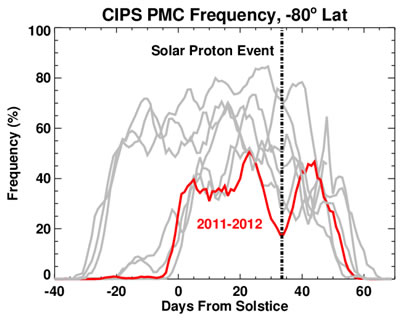|
STATUS:
11.17.2014
Instrument Status:
The AIM spacecraft continues to perform well. All of the subsystems are operating nominally and within expected parameters.
CIPS:
The CIPS instrument continues to perform well, with no health issues. We have recently investigated the suggestion that solar proton events (SPEs) can indirectly affect mesospheric temperatures and thus PMCs. SPEs produce HOx in the lower mesosphere, which destroys ozone. SPE-induced ozone depletion means less heating by ozone, and thus a cooler polar lower mesosphere. The polar cooling should induce a change in the temperature gradient with latitude, resulting in a westerly zonal wind shift. This would cause eastward gravity waves to break at lower altitudes, causing a downward shift of the residual circulation. Consequently, there would be less cooling of the summer polar mesopause and fewer PMCs.
The only two large SPEs that have occurred during the AIM record were on 23-24 January 2012 and 7-11 March 2012. Jackman et al. (2014) investigated the atmospheric effects of these SPEs and showed that based on the total NOx production, they were the 12th and 10th largest SPEs in the past 50 years, respectively. The March SPE was too late to impact PMCs. In theory, however, the January SPE could have resulted in fewer PMCs in late January to early February. Jackman et al. (2014) confirmed summer polar (60-82.5°S) mesosphere (70-80 km) HOx increases up to about 0.5 ppbv one to two days after the SPE, which were accompanied by ozone depletions of >20%. Their model did not predict a large warming, however, and in agreement with this, the CIPS data did not show any decrease in PMCs after the SPE. In fact, as the figure here shows, PMCs were already near a minimum when the Jan SPE began, and increased by about 20% over the next week.
Day-to-day variability in PMCs is strongly affected by interhemispheric coupling (Karlsson et al., 2009) and planetary wave activity (Siskind and McCormack, 2014), which complicates detection of any SPE effects. Indeed, processes such as these are likely responsible for the PMC increase immediately following the SPE in January 2012. The overall conclusion from this work is that the effects of SPEs on summer polar mesopause temperatures are too small relative to the effects of other mechanisms to unambiguously identify the SPE impacts, unless a storm is significantly larger than the 23-24 January 2012 SPE.

Figure Caption. CIPS PMC frequencies for southern hemisphere seasons 2007-2008 through 2013-2014. The 2011-2012 season is in red. The 23-24 January 2012 SPE is denoted by the black dot-dash line. Note that PMCs increased immediately following the SPE, in contrast to predictions of expected SPE impacts.
References:
Jackman, C.H., C. E. Randall, V. L. Harvey, S. Wang, E. L. Fleming, M. Lopez-Puertas, B. Funke, and P. F. Bernath, Middle atmospheric changes caused by the January and March 2012 solar proton events, Atmos. Chem. Phys. 14, 1025-1038, doi:10.5194/acp-14-1025-2014, 2014.
Karlsson, B., C.E. Randall, V.L. Harvey, M. Mills, S. Benze, S.M. Bailey, J.M. Russell, III, Intra-seasonal variability of polar mesospheric clouds due to inter-hemispheric coupling, Geophys. Res. Lett. 36 (20), doi:10.1029/2009GL040348, 2009.
Siskind, D. E., and J. P. McCormack, Summer mesospheric warmings and the quasi 2 day wave, Geophys. Res. Lett., 41, 717–722, doi:10.1002/2013GL058875, 2014.
SOFIE:
The SOFIE instrument continues to operate normally. Recent efforts have resulted in the production of over 1000 days of the new V1.3 data, and these results have been made available to the AIM Science Team for initial evaluation before public release. The changes in V1.3 include improved signal drift corrections, and the use of SABER atomic oxygen in the SOFIE (non-LTE) temperature retrievals. The SOFIE temperatures are several degrees colder in the Northern and Southern Hemispheres, and now match SABER temperatures in the South. Another exciting development is that the new signal corrections appear to have allowed meteoric smoke observations in the North, for the first time. SOFIE observations of the recent 2014 Northern PMC season indicate striking oscillations in PMCs, temperature, and water vapor. These oscillations have a periodicity 27 days and are highly correlated with the 27-day solar rotation (with a time lag of 6 days), as indicated in the figure below. The figure shows the residual PMC IWC and temperature (0.002-0.03 mb average) compared to the residual solar Lyman-alpha. The residuals were determined using polynomial filtering.

|
